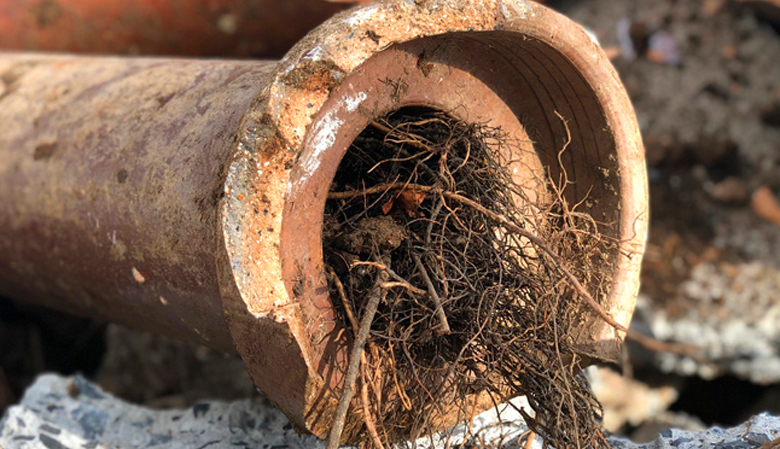Imagine using your toilet like you always do. You flush it and think your business is over. So you continue with your day and head out to run some errands.
That’s when you see it. A large stinking puddle of water is flooding your lawn. You frantically call up a plumber to fix it. Surely it’s just a leak, right? The plumber does their inspection as you watch them nervously. That’s when they find the last thing you’d ever imagine being in your pipes: Tree roots.
Your stressed mind fires off questions at a rapid pace:
- Why are there roots in my pipes?
- How’d they get there?
- How can I get rid of them?
Our team at Monkey Wrench Plumbing is here to answer these questions and calm your restless mind. We’ve been in the plumbing business for over fourteen years, and we’ve seen many trees invade pipes from the South Bay to the Valley.
We promise that by the time you finish this article, you know why and how roots get into your pipes, how to get rid of them, and how to fix the damage caused by mother nature.

Why Are There Roots in My Pipes?
Trees and bushes around your home will seek the easiest source of nutrients they can get their roots on. Most of the time, they’ll find food in your sewer pipes. Roots will grow toward your sewer lines to absorb water, nitrogen, phosphorus, and potassium.
If you have even the slightest crack in your pipes, roots will find it. What’s worse is that once they’ve found a food source, they will grow into your line and get longer and thicker. When given enough time, multiple roots can break into a line and completely back it up.
But how did you get a leak in the first place? It didn’t just happen out of the blue!
Trees and bushes like these can get into your sewer line.

How Do I Get Cracks in My Sewer Line?
There are a few ways to get cracks in your sewer line. They are:
- Cleaning too frequently – If you use chemical drain cleaners or hydro-jet (using pressurized water to fix blockages) your pipes too often, your lines will become weak and break.
- Earthquakes – Intense shifts in the earth can also cause lines to unhook and leak.
- Parking over lines – If you park on your lawn, your lines can start to collapse due to the weight. This leaves pipes susceptible to root intrusion.
- Old age – Nothing lasts forever. Eventually, piping can start to break due to old age.
So, what can you do about damaged pipes? You have a few options, which we’ll outline in the next section.
What Can I Do to Get My Pipes Fixed From Root Damage?
When a plumber inspects your pipes, they will run a camera through it to determine how to proceed. Once they know what they’re working with, they can give you options such as:
- Replacing sections of pipe – If the damage to your pipes from nearby roots is minimal, you can replace a section of pipe.
- Epoxying the pipe – If damage runs the length of your sewer line, a plumber can use a resin mixture to fix it. For this option, a pipe liner is measured, cut, and filled with epoxy. The epoxy-saturated liner is inserted into the existing pipe and expanded. Once the epoxy hardens, the liner is removed.
- Pipe bursting – If a plumber sees your pipe is beyond repair with a drain camera, you can invest in a pipe burst. This is a trenchless method of fixing a line that runs a drill tip and new pipe through the old pipe to burst it open. The remnants of the old pipe are left around the newly installed pipe and don’t interfere with its operation.
When you’re talking to your plumber about your options, make sure to communicate your priorities. Are you on a budget? Do you want to have your lawn look as close to pristine as possible after your service? Highlighting your needs will make sure you get the right service for you.
Monkey Wrench Plumbing technicians digging a trench to replace sewer lines.

How to Avoid Roots in the Future
Roots are persistent. If they find an easy food source, they’ll grow toward it, even if there’s a pipe in the way. If you don’t want to get roots in your pipes again, make sure you:
- Don’t overuse chemical drain cleaners.
- Try planting bushes or trees away from your sewer line.
- Avoid parking on your lawn.
- Get an annual camera inspection of your pipes.
- Watch for thriving plants in your yard when you’re having drain issues.
If you follow these tips, you can help make your sewer lines root-resistant.
Want to know how using a drain cleaner could be the reason for your most recent sewer leak? Read Can I Use Drain Cleaner On My Pipes? to know when chemical drain cleaners are okay to use and when they can cause severe damage to your pipes.
If you want root-free pipes in the future and peace of mind, call us at
+19169176280 or book an appointment online via our Drains Form. We can run a camera through your pipes to show you how they look and what’s in them.

